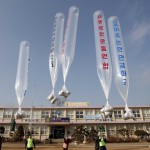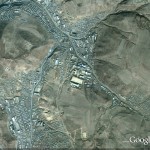UPDATE 2: And also on Monday the South Korean government lifted the ban on South Koreans visiting the Kaesong Industrial Zone.
UPDATE 1: As of Monday, the DPRK has not retaliated against either the balloons or the ROK naval drill that took place on Yonpyong. As a precaution, the ROK government has prevented South Korean workers from entering the Kaesong Zone.
ORIGINAL POST: For several years activists in the ROK have periodically floated balloons across the DMZ which contain cash, propaganda leaflets, and even radios. You can learn yet more about the leaflets here.
The DPRK has complained about these balloons on many occasions, and has at least twice threatened to cut off access to the Kaesong Industial Zone in retaliation. The first time was in November 2008. The second time was in May 2010.
Well last weekend activists launched balloons from Yonpyong Island (recently shelled by the DPRK):
North Korea now claims it will fire at the South Korean islands used to launch these balloons. According to Yonhap:
North Korea lashed out Friday at South Korea for allowing anti-Pyongyang propaganda leaflets to be sent across their border, as activists vowed to send more from a South Korean island devastated by North Korean shelling last month.
The leaflets, often mixed with U.S. dollar bills, DVDs and radios, are sent in giant balloons across the 4-kilometer-wide Demilitarized Zone between the Koreas.
The North’s official Web site, Uriminzokkiri, said the bills are “nothing more than waste paper” and that the leaflets do little to undermine the pride of its people in the communist regime.
“Such confrontational madness will only snap up the extraordinary alarm and ire of our army and people,” it said in a commentary.
North Korea’s military has warned it would shell South Korean sites used to send propaganda leaflets and broadcasts. On Nov. 23, the North shelled the western South Korean island of Yeonpyeong, killing two marines and two civilians in its first direct attack on an inhabited region in the South since the 1950-53 Korean War.
North Korea cited the South’s live-fire drills that day as a reason for its shelling, saying its territorial waters were infringed upon. The South denies shooting toward the North.
In a related development, a group of North Korean defectors have entered Yeonpyeong Island this week and are preparing to send about 200,000 leaflets denigrating the North Korean leadership.
Park Sang-hak, head of Fighters for Free North Korea, told Yonhap News Agency that should wind conditions turn favorable, his group will send the leaflets as early as Saturday.
The South Korean military plans to hold one day of live-fire exercises on Yeonpyeong between Saturday and Tuesday despite the North’s threat of retaliation. North Korea says any shells fired from Yeonpyeong are bound to violate its waters because it does not respect the Yellow Sea border drawn by a U.S. general at the end of the Korean War, which ended in a truce.
In an act of support for the propaganda activities, Shin Ji-ho, a ruling party member, told Yonhap that he and other legislators plan to send 100,000 leaflets in “truth balloons” on Jan. 8, the date North Korea’s 20-something heir apparent, Kim Jong-un, was born.
Read the full story here:
N. Korea slams S. Korea over propaganda leaflets as activists vow to send more
Yonhap
Sam Kim
12/17/2010


